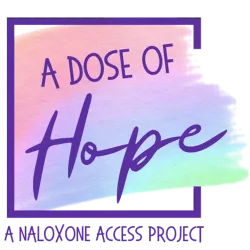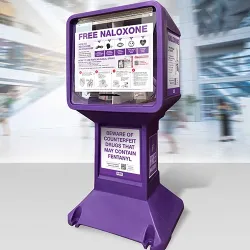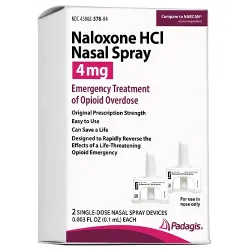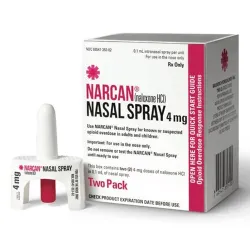 What is the Dose of Hope Project? The landscape of the opioid epidemic is a reality and has devastated too many families. Strategically placing naloxone in accessible kiosks can mean the difference between permanent tragedy and a second chance at life. When an overdose strikes, bystanders can immediately provide this life-saving antidote - opening the door to recovery and treatment.
What is the Dose of Hope Project? The landscape of the opioid epidemic is a reality and has devastated too many families. Strategically placing naloxone in accessible kiosks can mean the difference between permanent tragedy and a second chance at life. When an overdose strikes, bystanders can immediately provide this life-saving antidote - opening the door to recovery and treatment.
Naloxone distribution is compassionate harm reduction. It recognizes addiction as a health issue, not a personal failure. By making naloxone readily available, we demonstrate our belief that every community member's life is worth saving and that they deserve the opportunity to heal. These kiosks represent real hope against the opioid crisis.
Want to be part of Fremont County's movement to reduce overdoses?
Join the fight against opioid overdoses in Fremont County, Colorado. Your involvement can make a real difference in saving lives and supporting our community. Whether you're a concerned citizen, a family member of someone at risk, or a professional working in healthcare or social services, there are several ways you can contribute to this vital cause. Here are some concrete steps you can take to get involved and make an impact:
- Get trained
on overdose prevention and naloxone administration - Access Training
by visiting YouTube for video training - Contact Public Health and Environment
via email or at 719-276-7450 to request an in-person training for your organization - Get free naloxone
in the FCDPHE lobby at 201 N. 6th St., Cañon City
Kiosks Locations
- Department of Human Services
172 Justice Center Road, Cañon City - Penrose Community Library
35 7th Ave, Penrose - John C Fremont Public Library
130 Church Avenue, Florence - Mercy Today Ministries & Church
1336 Elm Avenue, Canon City, CO 81212 - Pueblo Community College Fremont
51320 US-50, Canon City, CO 81212 - Contact Public Health and Environment via contact form or at 719-276-7450 if you are interested in learning more about sponsoring A Dose of Hope kiosk.
What Is Harm Reduction And Why Provide Kiosks?
- Definition
 Harm reduction provides evidence-based interventions focused on reducing harm to people. Everything from bike helmets, seatbelts, brushing your teeth and sunscreen, can be considered "harm reduction".
Harm reduction provides evidence-based interventions focused on reducing harm to people. Everything from bike helmets, seatbelts, brushing your teeth and sunscreen, can be considered "harm reduction". - Connection
Harm reduction is a connector between addiction and recovery. - Effectiveness
Overdose education and naloxone distribution can reduce opioid-related mortality. - Accessibility
The kiosks remove barriers by meeting people where they are. - Comparison
Carrying naloxone is no different than carrying an epinephrine auto-injector (known by the brand name EpiPen) for someone with allergies. It simply provides an extra layer of protection for those at a higher risk for overdose.
What Are Some Facts About Naloxone (Narcan)?
 Legal Protection
Legal Protection
911 Good Samaritan Law, C.R.S.§18-1-711 : allows any individual to administer naloxone (even expired) to a person believed to be suffering from an overdose. The individual is immune from prosecution.- FDA Approval
NARCAN nasal spray was approved by the FDA in 2015 as a prescription drug. In March 2023 they approved over-the-counter naloxone to help reduce drug overdose deaths. - Effectiveness
Naloxone is a lifesaving emergency treatment that can reverse an opioid overdose—including heroin, fentanyl, and prescription opioid medications—when given in time. It is a medicine with no abuse potential, and it is not a controlled substance. - Safety
If used by a person who doesn't use opiates, at worst it may be uncomfortable. It is safe. - Accessibility
Naloxone is easy to use and small to carry. Anyone can use naloxone to help reduce opioid overdose deaths.
What's The Data?
- Local Impact
Fremont County is in the top 10 Colorado counties with the highest opioid-related death rate per capita.  County Statistics
County Statistics
Fremont County experienced 35 opioid deaths (2020-2023).- State Statistics
Opioid overdose deaths in Colorado were 3,374 (2020-2022). - National Context
Nationally, in over 40% of overdose deaths, someone else was nearby. Having naloxone available allows bystanders, friends and loved ones to help. - Effectiveness Study
A naloxone distribution study reported that of 399 overdoses where naloxone was used, 89% were reversed. - Local Program Impact
60% of Green Thumb Initiative's clients since 2016 had substance use disorder (269 of 453). Twenty four clients overdosed on opioids with 1 death. Over 75% of SUD clients had child protection issues.
